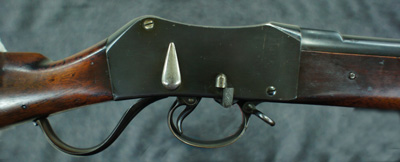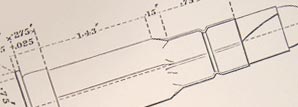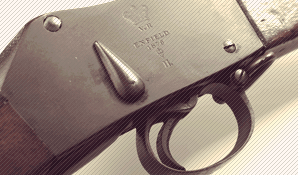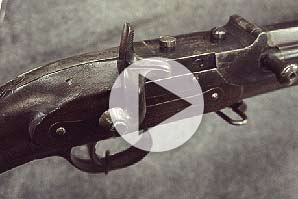A Weapon is Born
A Weapon is born
An 1860’s Arms Race
The changes in military rifle taking place all over Europe during that second half of 19th Century took had left military planners both in Great Britain and Europe in a dilemma. The introduction of the Dreyse Pattern Needle Rifle in 1864 caused shockwaves and in effect an arms race, in an instant ,the Needle fire rifle had set about the accelerated development of the breech loading rifle as a weapon of choice in all the industrialised countries. The trend too, for smaller projectiles with a great ballistic accuracy and velocity were beginning to become the requirement.
In Great Britain, the relatively slow movement towards breech loading firearms had seen little movement, the Pattern 1853 percussion, it was the muzzle loading .577” Enfield rifle, that had been the mainstay of service ordnance over the last fifteen years. The P1853 had been produced in vast numbers and had seen over 900,000 exported to the Confederate and Union armies during the American civil war, the death and carnage dealt out by that weapon unsurpassed by any weapon before . The swing towards self-contained cartridges, perfected on the patents of George Henry Daw, and Frenchman Clement Pottet meant by 1860 a fully enlosed metallic cartridge, with is own integral primer, powder and bullet could be supplied in volume. In England on Jan 15 1866 Colonel Edward Mounier Boxer of the Royal Arseanl in Woowich , patented a perfected centre fire cartridge made from a rolled brass foil, with a series of strenghtening base cups and a primer which acted as a form of rivet, it was cheap and easy to produce, provided excellent breech sealing properties and measured powder quantities for consistent shooting.
In 1864, the decision had been made to arm the British Army with its own centre fire weapon, The War office had placed an advertisement on the 23rd August 1865 for the great and the good in the London and Birmingham gun trades’ to submit designs to convert the P53 Enfield to a breech loader, it had to be a stop gap until a purpose made breech loading rifle could be developed.
The army chose upon the hinged breech mechanism of Jacob Snider, whose patent No1828 21st June 1862 was a simple expedient adaption of the existing Enfield ‘P53 rifle. Boxers patent cartridge worked hand in hand with the Snider, and in England breech loading firearms took its first tentative steps with full adoption of the P1866 – Snider Enfield conversion trapdoor breech. The Snider was approved List of Change No 1327 on 18th September 1866, as the Mk1.

The Snider was a simple conversion, a P1853 rifle with a retrofitted, hinged breech to take a .577” centre fire cartridge. The hammer drove an integral central rod and firing pin contained in the Snider block, which in turn exploded the primer. To clear the spent round, the block slid back and a claw pulled the cartidge clear by engaging on the rim of the cartdridge. It was effective and very popular, albeit being at the time a simple stopgap.
The Competition 1867
In order to select the next generation of military rifles, the British War office held a prize competition in 1865 with a prize money of £5000 to select from various designers a weapon that utilised a smaller, higher velocity projectile than the .577” snider. The trials were to take place within the next two years, with an ultimate winner to be announced in 1869, to lure out potential designers On the 25th June 1865, the Secretary of War issued the following advertisement
“The ultimate armament of the British Infantry with breech loading rifles has been determined upon, The Secretary of State is desirous of receiving proposals on the subject from gun makers’ and others who would be disposed to enter into competition for the production of the best military weapon.”
The resultant competition saw various well know names in gun manufacture offer prototypes for consideration, entrants were Messrs Peabody, Henry, Fosbery, Albibi/Brendalin, Burton, Martini, Joslyn and Remington.

The Albini Rifle Breech

The Joslyn Rifle Breech
However the resulting test proved inconclusive with no particular rifle achieving the desired performance criteria. Two examples however had stood out, but each rifle had its shortcomings. It was only when the best attributes of each design were put together that a simple and effective rifle was born.

The favoured action was that of Frederich Martini, (1833-1897) a Swiss gun maker of Hungarian origin. Martinis’ action was a simple falling block action. Martini had been accused, (quite rightly in reality), of improving and re-engineering the American Peabody falling block mechanism.

The Martini Trial Rifle offered to the War Office 1868
Martini had devised a block that held an enclosed striker. The action of the under lever dropped the block, cocked the mechanism and ejected the spent round in one action. His selected cartridge was a .450” calibre Boxer brass round very similar in design to the American 45/70. The designation was to be the long chamber Martini .

Martini had designed a simple nipple shaped cocking indicator which was to extend in the thumb-grip, however a tear shaped indicator was added to the trigger axis, this was mounted on the side of the action and gave a simple, visual indication. Also a simple safety catch was installed on the right side of the action. The Martini Action revolved around a central axis and lever. The lever depressed the breech block which contained a central firing pin and spring. A tumber, pivotting on the central axis sat on top of the trigger sear and cocked the mechanism.
When the trigger was depressed the tumber was released allowing the firing pin to shoot forward and strike the primer in the base of the cartridge. To eject the spent round, the breech block was lowered, which in turn pressed the angles extractor base, held by a transverse screw in the front of the action. The extractor was then moved backwards and the two claws, mounted on the extractor arm withdrew the cartridge. The whole cycle could them be repeated.


The rifling system selected was that of Edinburgh gunsmith Alexander Henry, (1828-1894) which consisted of a seven groove polygonal rifling, with one twist in 22” (56cm). Barrel length was to be 33.2” (84.2cm). The Henry rifling system was found superior in all trials, accurate and powerful. The basis of the rifling was in reality a modernisation of the Whitworth system, which was developed in 1854. The bore was .450” calibre, across the lands of the rifling .458”-.464”.

The Breech of the 200 trails Martinis made at Enfield in 1871, note the large hooked lever, safety catch, screw in axis pin and lack of thumb sear on the rear hump. All omitted on the service rifle. This rifle has the long chamber to suit the .450" Boxer long cartridge.
The first trials pattern P1871 Martini Henry rifle were manufactured the Royal Small Arms factory at Enfield lock, of which over 200 examples were made. The main result of the field testing was that a revision was to be made to the chamber and the powder load increased to achieve a satisfactory velocity at 1300 feet per second (400m/ps). Cartridge manufacturer, Eley, had been independently experimenting with a bottle shaped Boxer round. The increased load and shorter chamber requirement of this new technology, gave the Martini significant accuracy and velocity benefits up to 1360 fps. The new chamber was designated in .577”/.450” calibre. The cartridge was to contain 85 grains of FFG black powder and measured 3.15” when loaded. The bullet was a 480 grain unjacketed lead slug, measuring .450” diamter and paper patched to .458”..
On 13th April 1871 the orders were placed at the Royal Small Arms factory at Enfield for full scale production of the Martini Henry Rifle, between then and 1874 The Martini Henry was trialled throughout the Empire by various regiments, and finally on September 28th 1874 it was authorised for full issue to the British Army.






